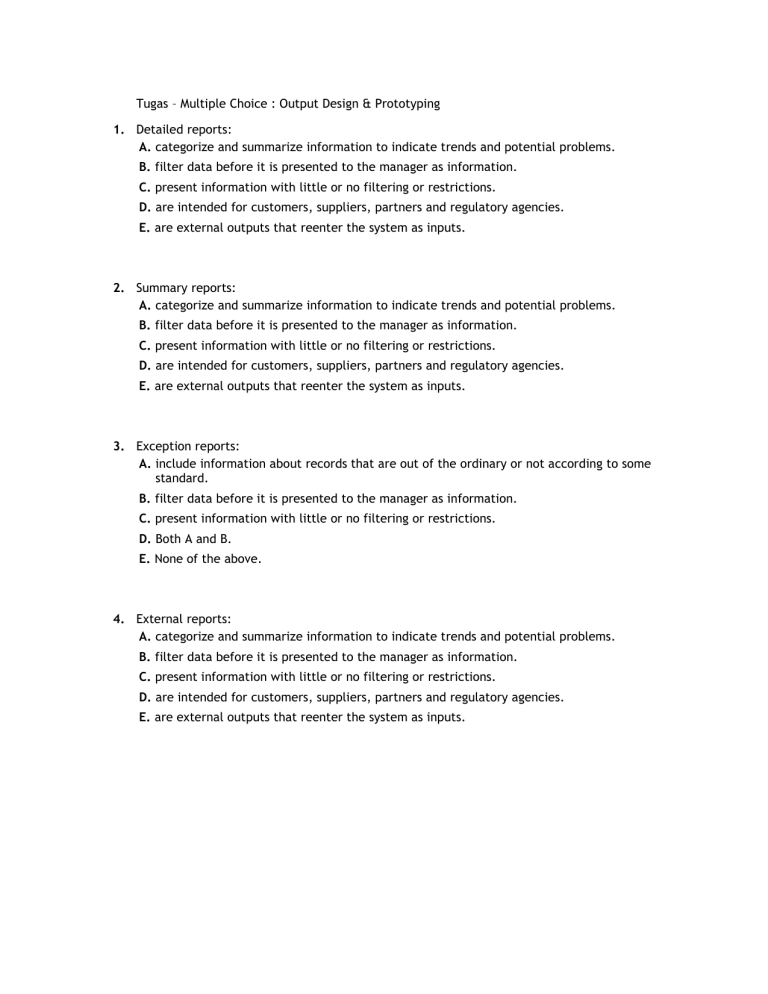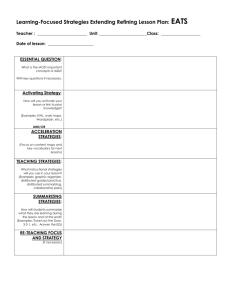1. A. B.

Tugas – Multiple Choice : Output Design & Prototyping
1. Detailed reports:
A. categorize and summarize information to indicate trends and potential problems.
B. filter data before it is presented to the manager as information.
C. present information with little or no filtering or restrictions.
D. are intended for customers, suppliers, partners and regulatory agencies.
E. are external outputs that reenter the system as inputs.
2. Summary reports:
A. categorize and summarize information to indicate trends and potential problems.
B. filter data before it is presented to the manager as information.
C. present information with little or no filtering or restrictions.
D. are intended for customers, suppliers, partners and regulatory agencies.
E. are external outputs that reenter the system as inputs.
3. Exception reports:
A. include information about records that are out of the ordinary or not according to some standard.
B. filter data before it is presented to the manager as information.
C. present information with little or no filtering or restrictions.
D. Both A and B.
E. None of the above.
4. External reports:
A. categorize and summarize information to indicate trends and potential problems.
B. filter data before it is presented to the manager as information.
C. present information with little or no filtering or restrictions.
D. are intended for customers, suppliers, partners and regulatory agencies.
E. are external outputs that reenter the system as inputs.
5. Turnaround reports:
A. categorize and summarize information to indicate trends and potential problems.
B. filter data before it is presented to the manager as information.
C. present information with little or no filtering or restrictions.
D. are intended for customers, suppliers, partners and regulatory agencies.
E. none of the above.
6. Tabular output is:
A. text and numbers placed into designated areas or boxes of a form or screen.
B. presented as columns of text and numbers.
C. the use of pictorial charts to convey information in ways that demonstrate trends and relationships.
D. information presented in a format other than traditional numbers, codes and words.
E. none of the above
7. Zoned output is:
A. text and numbers placed into designated areas or boxes of a form or screen.
B. presented as columns of text and numbers.
C. the use of pictorial charts to convey information in ways that demonstrate trends and relationships.
D. information presented in a format other than traditional numbers, codes and words.
E. none of the above
8. Graphic output is:
A. text and numbers placed into designated areas or boxes of a form or screen.
B. presented as columns of text and numbers.
C. the use of pictorial charts to convey information in ways that demonstrate trends and relationships.
D. information presented in a format other than traditional numbers, codes and words.
E. none of the above
9. A line chart:
A. is useful for summarizing percentages of a whole within a single series of data.
B. is useful for summarizing and showing the change in data over time.
C. is useful for summarizing and showing data at regular intervals.
D. is useful for comparing series or categories of data.
E. is useful for comparing different aspects of more than one series of data.
10. An area chart:
A. is useful for summarizing percentages of a whole within a single series of data.
B. is useful for summarizing and showing the change in data over time.
C. is useful for summarizing and showing data at regular intervals.
D. is useful for comparing series or categories of data.
E. is useful for comparing different aspects of more than one series of data.
11. A bar chart:
A. is useful for summarizing percentages of a whole within a single series of data.
B. is useful for summarizing and showing the change in data over time.
C. is useful for summarizing and showing data at regular intervals.
D. is useful for comparing series or categories of data.
E. is useful for comparing different aspects of more than one series of data.
12. A pie chart:
A. is useful for summarizing percentages of a whole within a single series of data.
B. is useful for summarizing and showing the change in data over time.
C. is useful for summarizing and showing data at regular intervals.
D. is useful for comparing series or categories of data.
E. is useful for comparing different aspects of more than one series of data.
13. A radar chart:
A. is useful for summarizing percentages of a whole within a single series of data.
B. is useful for summarizing and showing the change in data over time.
C. is useful for summarizing and showing data at regular intervals.
D. is useful for comparing series or categories of data.
E. is useful for comparing different aspects of more than one series of data.
14. A scatter chart:
A. is useful for summarizing percentages of a whole within a single series of data.
B. is useful for summarizing and showing the change in data over time.
C. is useful for comparing series or categories of data.
D. Both B and C.
E. None of the above.
15. Computer outputs should be simple to read and interpret. Which of the following is not a guideline that applies to this principle?
A. every output should have a title
B. every output should be dated and time stamped
C. only required information should be printed or displayed
D. information should never have to be manually edited to become usable
E. every output should compare different aspects of more than one series of data
16. Which of the following is not a design issue related to output design?
A. How frequently is the output generated?
B. How many pages or sheets of output will be generated for a single copy of a printed output?
C. How many forms will be printed each day? Week? Month? Year?
D. Have the distribution controls been finalized?
E. Does the output require multiple copies? If so, how many?




